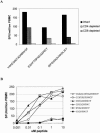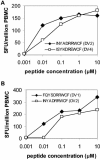Early T-cell responses to dengue virus epitopes in Vietnamese adults with secondary dengue virus infections
- PMID: 15827181
- PMCID: PMC1082776
- DOI: 10.1128/JVI.79.9.5665-5675.2005
Early T-cell responses to dengue virus epitopes in Vietnamese adults with secondary dengue virus infections
Abstract
T-cell responses to dengue viruses may be important in both protective immunity and pathogenesis. This study of 48 Vietnamese adults with secondary dengue virus infections defined the breadth and magnitude of peripheral T-cell responses to 260 overlapping peptide antigens derived from a dengue virus serotype 2 (DV2) isolate. Forty-seven different peptides evoked significant gamma interferon enzyme-linked immunospot (ELISPOT) assay responses in 39 patients; of these, 34 peptides contained potentially novel T-cell epitopes. NS3 and particularly NS3200-324 were important T-cell targets. The breadth and magnitude of ELISPOT responses to DV2 peptides were independent of the infecting dengue virus serotype, suggesting that cross-reactive T cells dominate the acute response during secondary infection. Acute ELISPOT responses were weakly correlated with the extent of hemoconcentration in individual patients but not with the nadir of thrombocytopenia or overall clinical disease grade. NS3556-564 and Env414-422 were identified as novel HLA-A*24 and B*07-restricted CD8+ T-cell epitopes, respectively. Acute T-cell responses to natural variants of Env414-422 and NS3556-564 were largely cross-reactive and peaked during disease convalescence. The results highlight the importance of NS3 and cross-reactive T cells during acute secondary infection but suggest that the overall breadth and magnitude of the T-cell response is not significantly related to clinical disease grade.
Figures








Similar articles
-
Immunodominance changes as a function of the infecting dengue virus serotype and primary versus secondary infection.J Virol. 2014 Oct;88(19):11383-94. doi: 10.1128/JVI.01108-14. Epub 2014 Jul 23. J Virol. 2014. PMID: 25056881 Free PMC article.
-
Identification of cytotoxic T lymphocyte epitopes in dengue virus serotype 1.J Med Virol. 2015 Jul;87(7):1077-89. doi: 10.1002/jmv.24167. Epub 2015 Mar 16. J Med Virol. 2015. PMID: 25777343
-
Cross-reactive T-cell responses to the nonstructural regions of dengue viruses among dengue fever and dengue hemorrhagic fever patients in Malaysia.Clin Vaccine Immunol. 2007 Aug;14(8):969-77. doi: 10.1128/CVI.00069-07. Epub 2007 Jun 13. Clin Vaccine Immunol. 2007. PMID: 17567768 Free PMC article.
-
Cross-Reactive T Cell Immunity to Dengue and Zika Viruses: New Insights Into Vaccine Development.Front Immunol. 2019 Jun 11;10:1316. doi: 10.3389/fimmu.2019.01316. eCollection 2019. Front Immunol. 2019. PMID: 31244855 Free PMC article. Review.
-
T cell responses in dengue viral infections.J Clin Virol. 2013 Dec;58(4):605-11. doi: 10.1016/j.jcv.2013.10.023. Epub 2013 Oct 27. J Clin Virol. 2013. PMID: 24220605 Review.
Cited by
-
Cross-reactivity and expansion of dengue-specific T cells during acute primary and secondary infections in humans.Sci Rep. 2011;1:51. doi: 10.1038/srep00051. Epub 2011 Aug 1. Sci Rep. 2011. PMID: 22355570 Free PMC article.
-
HLA-A*0201-restricted CD8+ T-cell epitopes identified in dengue viruses.Virol J. 2012 Nov 5;9:259. doi: 10.1186/1743-422X-9-259. Virol J. 2012. PMID: 23121866 Free PMC article.
-
Use of a Recombinant Gamma-2 Herpesvirus Vaccine Vector against Dengue Virus in Rhesus Monkeys.J Virol. 2017 Jul 27;91(16):e00525-17. doi: 10.1128/JVI.00525-17. Print 2017 Aug 15. J Virol. 2017. PMID: 28592531 Free PMC article.
-
Timing of CD8+ T cell responses in relation to commencement of capillary leakage in children with dengue.J Immunol. 2010 Jun 15;184(12):7281-7. doi: 10.4049/jimmunol.0903262. Epub 2010 May 12. J Immunol. 2010. PMID: 20483770 Free PMC article.
-
Structural Influence on the Dominance of Virus-Specific CD4 T Cell Epitopes in Zika Virus Infection.Front Immunol. 2018 May 30;9:1196. doi: 10.3389/fimmu.2018.01196. eCollection 2018. Front Immunol. 2018. PMID: 29899743 Free PMC article.
References
-
- Bethell, D. B., J. Gamble, P. L. Pham, M. D. Nguyen, T. H. Tran, T. H. Ha, T. N. Tran, T. H. Dong, I. B. Gartside, N. J. White, and N. P. Day. 2001. Noninvasive measurement of microvascular leakage in patients with dengue hemorrhagic fever. Clin. Infect. Dis. 32:243-253. - PubMed
-
- Blok, J., S. M. McWilliam, H. C. Butler, A. J. Gibbs, G. Weiller, B. L. Herring, A. C. Hemsley, J. G. Aaskov, S. Yoksan, and N. Bhamarapravati. 1992. Comparison of a dengue-2 virus and its candidate vaccine derivative: sequence relationships with the flaviviruses and other viruses. Virology 187:573-590. - PMC - PubMed
-
- Brinton, M. A., I. Kurane, A. Mathew, L. Zeng, P. Y. Shi, A. Rothman, and F. A. Ennis. 1998. Immune mediated and inherited defences against flaviviruses. Clin. Diagn. Virol. 10:129-139. - PubMed
-
- Bunce, M., C. M. O'Neill, M. C. Barnardo, P. Krausa, M. J. Browning, P. J. Morris, and K. I. Welsh. 1995. Phototyping: comprehensive DNA typing for HLA-A, B, C, DRB1, DRB3, DRB4, DRB5 and DQB1 by PCR with 144 primer mixes utilizing sequence-specific primers (PCR-SSP). Tissue Antigens 46:355-367. - PubMed
-
- Burke, D. S., A. Nisalak, D. E. Johnson, and R. M. Scott. 1988. A prospective study of dengue infections in Bangkok. Am. J. Trop. Med. Hyg. 38:172-180. - PubMed
Publication types
MeSH terms
Substances
Grants and funding
LinkOut - more resources
Full Text Sources
Other Literature Sources
Molecular Biology Databases
Research Materials

